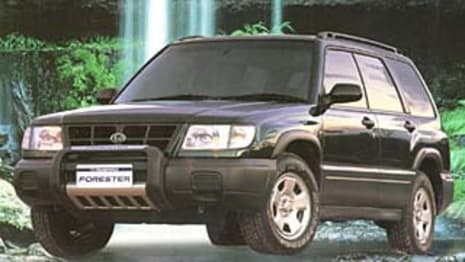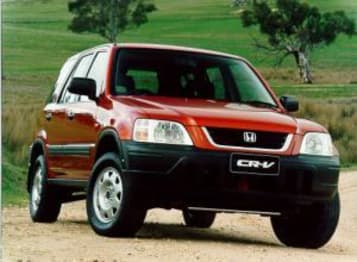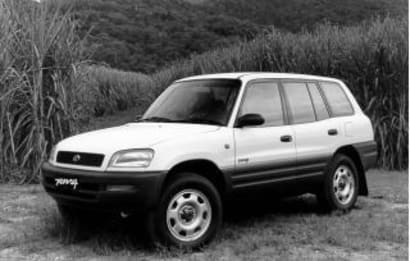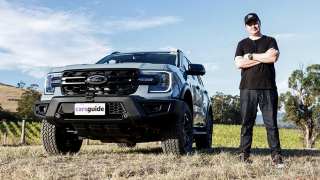
Used Subaru Forester review: 1997-2002
- Subaru Forester
- Subaru Forester 1997
- Subaru Forester 1998
- Subaru Forester 1999
- Subaru Forester 2000
- Subaru Forester 2001
- Subaru Forester 2002
- Subaru Forester Reviews
- Subaru Reviews
- Subaru SUV Range
- SUV
- Subaru
- Used Car Reviews
- Off road
What we like
- All-wheel drive is great on wet and slushy roads
- Surprising ability off road
- Good handling for an SUV
What we don't
- Base model GX didn't get airbags until 2000
- Low performing 2.0-litre engine
- Some road noise, particularly on course surfaces
What we like
- All-wheel drive is great on wet and slushy roads
- Surprising ability off road
- Good handling for an SUV
What we don't
- Base model GX didn't get airbags until 2000
- Low performing 2.0-litre engine
- Some road noise, particularly on course surfaces
The emergence of the four-wheel/all-wheel drive SUV wagon as the vehicle of choice for many, if not most Australians has been the most profound change in the market ever.
By the end of the ’90s Australians were abandoning the traditional big cars that had dominated the local market since the 1960s.
Instead, they were buying what would become known in time as SUVs, Sports Utility Vehicles, as fast as carmakers could build them.
SUVs promised them practicality and comfort in their everyday driving life, along with the promise of being able to explore the vast Australian bushland on their holidays.
Enter vehicles like the Subaru Forester, which arrived on these shores in 1997.
Model Watch
The Forester was based on the underpinnings of the Impreza passenger car, but didn’t much look like its small family car cousin.
Its upright four-door wagon body gave it a whole new look, oozing practicality and flexibility, and its all-wheel drive system promised off-road adventure.
The line-up at launch consisted of three variants: the GX, RX Limited, and the GT.
As the entry model, the GX came standard with cruise control, power steering, power windows and mirrors, a nudge bar, roof racks, remote central locking, and radio/cassette sound with four speakers.
Next in line was the RX Limited, which got you the added features of dual front airbags, ABS anti-lock braking, air conditioning, and automatic self-levelling suspension.
The GT came in 1998, and it featured dual front airbags, ABS anti-lock braking, air conditioning, alloy wheels, adjustable steering column, remote central locking, fog lamps, leather steering wheel, power mirrors and windows, roof racks, radio/cassette sound with four speakers, and automatic self-levelling suspension.
An update in 2000 saw the GX replaced by a model simply called the Forester, the RX Limited became the Limited, and the GT blazed on.

The update brought more performance thanks to added power and torque for the 2.0-litre engine, and more safety features, including dual front airbags and seat belt pretensioners.
Anyone hoping for things like Bluetooth to connect their iPhone or android device, sat nav, and a touch screen would have been sorely disappointed.
Those wanting a reversing camera, parking sensors, or a park assist system would also have been out of luck.
So too would anyone expecting climate control air conditioning, it was manual.
It was possible to have a sunroof on the GT, but only if you paid extra for the option.
The spare tyre was full-sized.
Cabin
Inside, there were seats for five, the boxy shape giving those riding in the Forester decent room.
The front seats had good head, elbow and legroom for comfortable travel, while the rear could take three without too much of a squeeze, particularly if they were kids.
Beyond that the luggage area was of a good size, and there were lots of other storage options throughout the cabin, with cupholders for drinks.
Engine
The main engine used in the Forester was a 2.0-litre, fuel-injected, single overhead camshaft, horizontally-opposed four that put out 90kW/176Nm at its respective power and torque peaks.
An updated model in 2000 saw those peaks grow by two kW and 12Nm respectively.
The sizzling GT engine was a slightly detuned WRX 2.0-litre turbocharged unit, also a ‘boxer’ layout, which produced 125kW (167 horsepower) and 240Nm.
It too got more sizzle in the 2000 update, peak power increasing to 130kW and maximum torque to 245Nm.
When pressed the regular Forester would do 0-100 km/h in a tick under 11 seconds; the GT’s performance was better, it would do it in just over eight seconds.
Both engines used petrol, 91-octane regular unleaded was recommended for the 2.0-litre, but 95-octane premium unleaded was needed for the GT’s turbo engine.

Transmission options across all models consisted of a four-speed automatic and a five-speed manual gearbox, both sending drive to all four wheels.
The Forester’s system had drive going to all wheels all the time, unlike other SUVs which only had part-time systems with drive primarily going through either the front or rear wheels.
At the heart of Subaru’s system was a centre transfer case with a viscous limited-slip differential. When it detected a difference in the rotation speed of the front and rear axles it automatically adjusted the torque split for optimum drive.
It worked well on road or off, delivering a level of safety a two-wheel drive car couldn’t match, along with a surprising ability off road.
Driving
The performance of the 2.0-litre engine was acceptable if you weren’t expecting the spring of a sports car leaving the line.
It got a little more power and torque a year after the initial launch, and that improved it a little.
The GT meanwhile, with its detuned WRX engine, had heaps of performance, but it wasn’t for everyone.
All-wheel drive made the Forester a safe driver, with plenty of grip in all conditions; it really came into its own on wet or slushy roads.
The handling was quite good for an SUV; it was generally balanced, and reasonably responsive for its type.
Road noise was an issue for some owners, particularly on course surfaces.
Off the road it had enough ground clearance to tackle tougher than normal conditions in the bush or on the beach,
Short front and rear overhangs were a limitation off-road, so drivers going bush had to be aware of them to avoid getting hung up.
Safety
Safety features were pretty basic in the first Forester, the base model GX didn’t even have the minimum of airbags and ABS anti-lock braking when it was introduced.
The Forester was awarded a three-star Driver Protection Rating in the annual Used Car Safety Rating.
That improved in 2000 when all models got dual front airbags and seat belt pretensioners, although the base model didn’t have ABS anti-lock braking until 2001.
The Forester was awarded a three-star Driver Protection Rating in the annual Used Car Safety Rating conducted by Monash University Accident Research Centre.
Built before they became mandatory in 2014 the Forester doesn’t have ISOFIX baby car seat attachments.
Any common issues
Reliability isn’t generally a problem with the Forester, although early ones are getting very long in the tooth and most have done lots of kilometres, and that can mean problems simply from normal wear and tear.
Carefully assess overall condition, look for evidence of crash repairs, the paint could be peeling away on upper surfaces, and the engine could be leaking or burning oil.
Owners mostly praise their cars, but many complain about the relatively low performance of the 2.0-litre engine, and there are lots of reports of poor radio reception.

Check for evidence of off-road use, typically damage to the underbody and other components exposed to gravel and flying rocks.
The GT was a hot performer, so check for signs of an overenthusiastic driver. Listen for noises from the turbocharger, and check for clutch wear on manuals.
Capped price servicing didn’t apply, but service costs aren’t excessive.
Like all cars it’s important that the Forester is regularly serviced, 10,000km or six months was recommended, so check for a service record.
A timing belt is used which needs to be changed every 100,000km.
The recommended oil is 5W-30.
The warranty when new was three years/100,000km.
MORE: If anything crops up, you’ll probably find it on our Subaru Forester problems page.
Owners view
Nathan Purvis: I’ve had my 2000 Limited for 12 years, and I’m happy with it. The engine isn’t built for performance, but it goes well, and has done everything I’ve asked of it. It’s now done more than 300,000km, and it hasn’t given me a moment’s trouble.
Sally Gibbs: As a young couple we bought our 1997 Limited because we wanted something smallish, but high enough to go off-road comfortably. It’s done almost 250,000km and it’s running perfectly.
Jarrod Cole: Our 1999 Limited had 50,000km on it when we bought it. It’s now got over 200,000km, and the only problems we’ve had have been with the radio reception, and a rear wheel bearing that went at 180,000km.
David Ryan: My Forrester has been reliable, fuel efficient, and fun to drive. It’s comfortable, has a great turning circle, and it’s quite large inside, but the 2.0-litre engine is gutless and the automatic transmission awful.
Rivals
Toyota RAV4
The original SUV was more fun car than serious transport.
Honda CR-V
Well-built but limited off-road with on-demand all-wheel drive.
Suzuki Vitara
Surprisingly good off-road, but lacks city comfort.
Verdict
Practical wagon with safety of all-wheel drive makes the Forester a sensible choice.
Pricing
| Year | Price From | Price To |
|---|---|---|
| 2002 | $2,530 | $6,600 |
| 2001 | $2,640 | $7,150 |
| 2000 | $2,200 | $7,150 |
| 1999 | $2,200 | $5,170 |
| 1998 | $2,200 | $5,170 |
| 1997 | $2,200 | $5,170 |
Pricing guides
Range and Specs
| Vehicle | Specs | Price* | |
|---|---|---|---|
| GX | 2.0L, ULP, 4 SP AUTO | $3,080 – 4,730 | 1997 Subaru Forester 1997 GX Pricing and Specs |
| RX Limited | 2.0L, ULP, 4 SP AUTO | $2,860 – 4,400 | 1997 Subaru Forester 1997 RX Limited Pricing and Specs |
Other cars to consider
$3,080
Lowest price, based on third party pricing data












